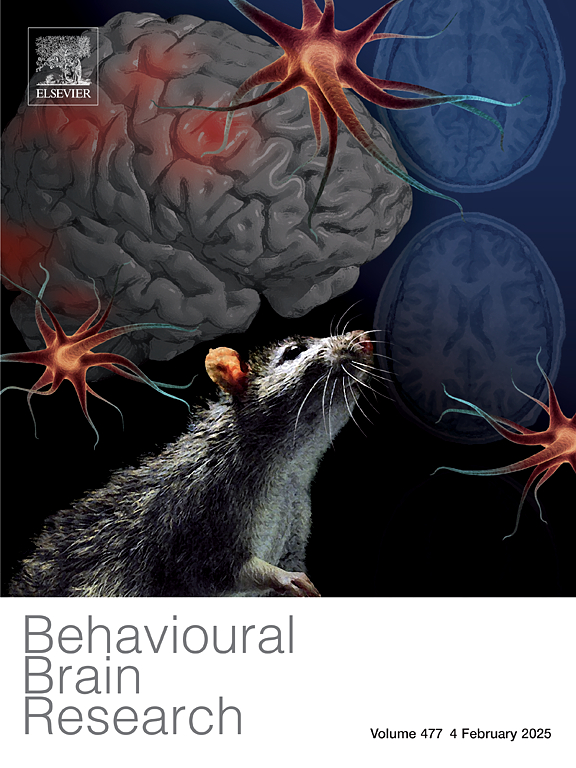小鼠开阔地和拉绳行为的纵向评价
IF 2.3
3区 心理学
Q2 BEHAVIORAL SCIENCES
引用次数: 0
摘要
自发行为包括在特定空间尺度上产生的高度有组织的运动序列的集合。例如,小鼠在野外建立基地时表现出有组织的运动(动态尺度),在拉绳时表现出双手协调(操纵尺度)。在神经系统疾病的小鼠模型中,已经观察到自发行为组织的中断,包括建立本垒和拉线。年龄对这些行为组织的影响还有待确定。本研究评估了10 ~ 20月龄小鼠在完全黑暗条件下空地运动组织和拉绳运动在多个时间点的纵向变化。使用运动的地形和运动学特征来研究与年龄相关的动态(即主场稳定性)和操纵(即达到一致性)规模运动组织的变化。在开阔场地,一般运动和主场措施保持稳定。然而,头部和运动比例的变化随着年龄的增长而变化。相比之下,拉绳性能在精度和运动学方面有所不同,随着年龄的增长,普遍有所改善。这些结果表明自发行为的组织与年龄相关的下降很小。由于小鼠模型通常用于模拟人类进行性疾病,因此考虑衰老的可翻译性是很重要的。这项工作为描述年龄和复合变量(如睡眠碎片化、运动)对自发行为的影响提供了基础。本文章由计算机程序翻译,如有差异,请以英文原文为准。
Longitudinal evaluation of open field and string-pulling behaviors in mice
Spontaneous behaviors involve collections of highly organized movement sequences produced on a specific spatial scale. For example, mice exhibit organized movement while establishing a home base in the open field (ambulatory scale) and bimanual coordination while string-pulling (manipulatory scale). Disruptions in the organization of spontaneous behaviors, including home base establishment and string-pulling, have been observed in mouse models of neurological disorders. The influence of age on the organization of these behaviors is yet to be determined. The current study evaluated longitudinal changes in the organization of mouse open field movement under completely dark conditions and string-pulling movement at multiple timepoints from 10 to 20 months of age. Topographic and kinematic characteristics of movement were used to investigate age-related changes in ambulatory (i.e., home base stability) and manipulatory (i.e., reaching consistency) scale movement organization. In the open field, general locomotion and home base measures remained stable. However, changes in heading and movement scaling varied with age. In contrast, string-pulling performance varied in measures of accuracy and kinematics, with general improvements observed with age. These results suggest minimal age-related decline in the organization of spontaneous behaviors. As mouse models are commonly used to model progressive diseases in humans, it is important to consider the translatability of aging. This work provides a foundation to characterize the effect of age and compounding variables (e.g., sleep fragmentation, exercise) on spontaneous behaviors.
求助全文
通过发布文献求助,成功后即可免费获取论文全文。
去求助
来源期刊

Behavioural Brain Research
医学-行为科学
CiteScore
5.60
自引率
0.00%
发文量
383
审稿时长
61 days
期刊介绍:
Behavioural Brain Research is an international, interdisciplinary journal dedicated to the publication of articles in the field of behavioural neuroscience, broadly defined. Contributions from the entire range of disciplines that comprise the neurosciences, behavioural sciences or cognitive sciences are appropriate, as long as the goal is to delineate the neural mechanisms underlying behaviour. Thus, studies may range from neurophysiological, neuroanatomical, neurochemical or neuropharmacological analysis of brain-behaviour relations, including the use of molecular genetic or behavioural genetic approaches, to studies that involve the use of brain imaging techniques, to neuroethological studies. Reports of original research, of major methodological advances, or of novel conceptual approaches are all encouraged. The journal will also consider critical reviews on selected topics.
 求助内容:
求助内容: 应助结果提醒方式:
应助结果提醒方式:


